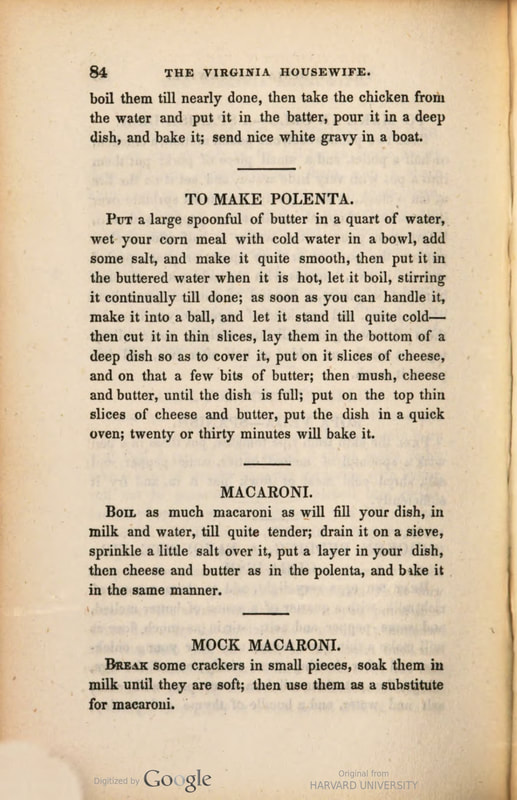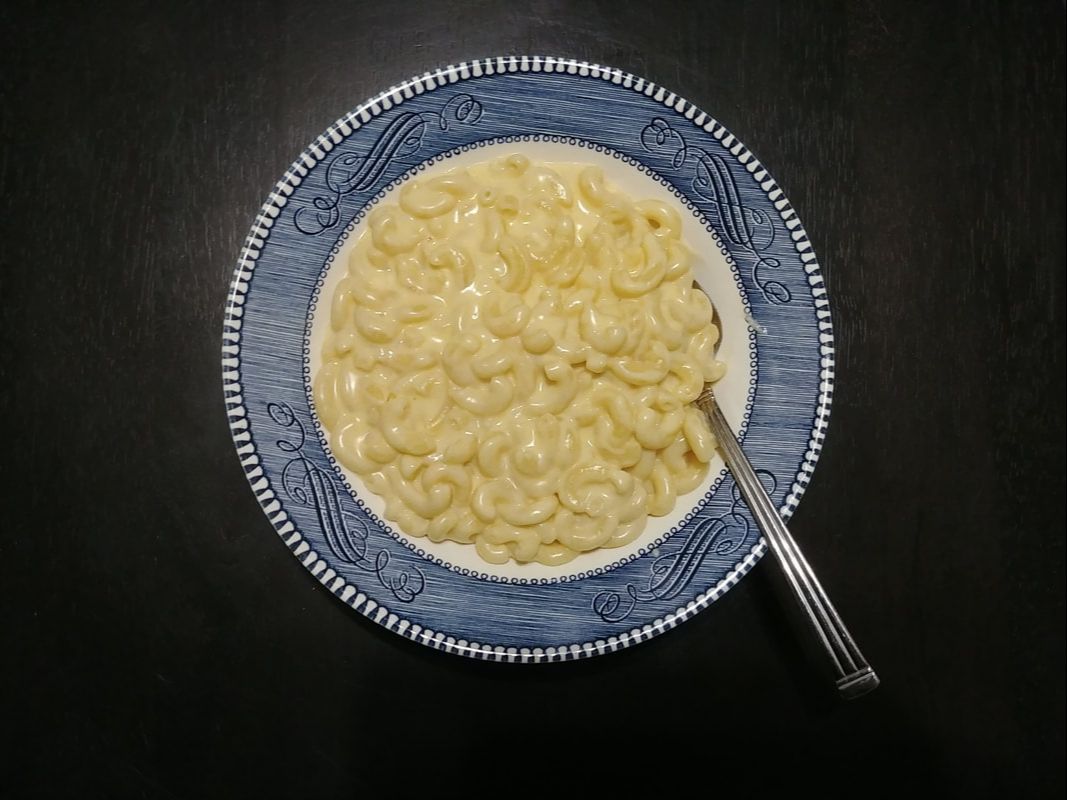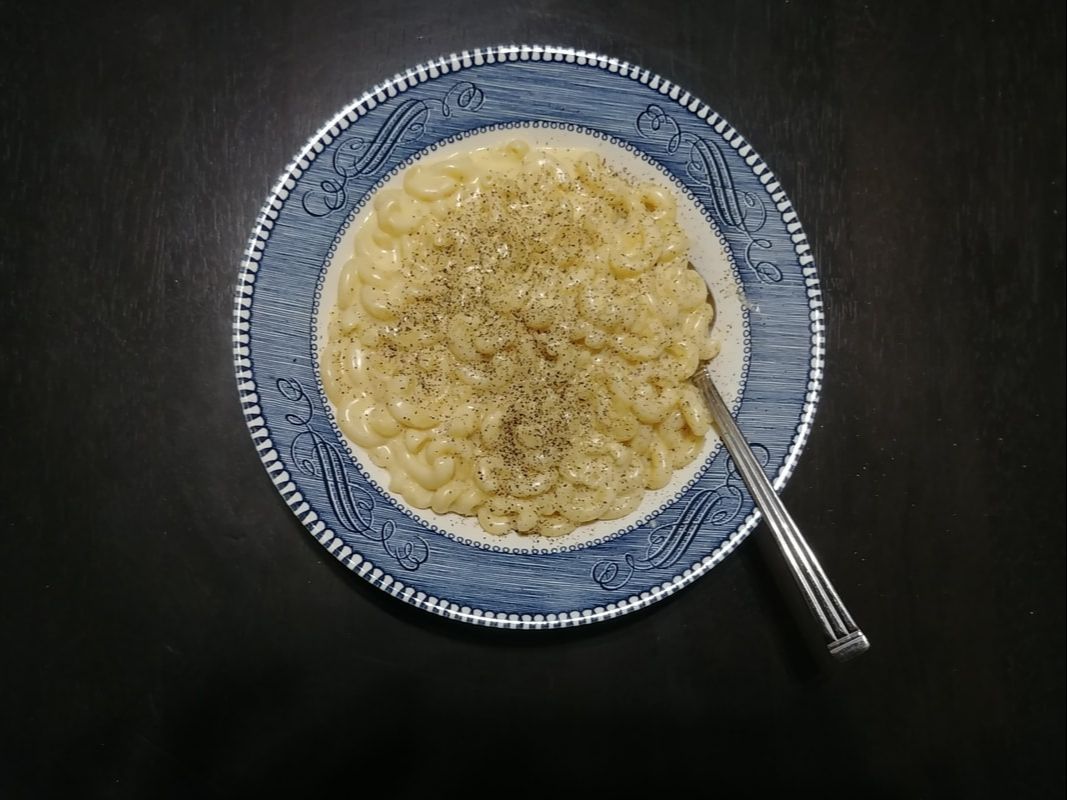|
I've given a couple of talks on the history of macaroni and cheese now, and invariably someone brings up how homemade macaroni and cheese is so much better than Kraft. And I agree! While Kraft Dinner, invented in 1937, is definitely an important part of American history, you don't have to like it to appreciate it.
Macaroni and cheese dates back quite far in Western history. I think macaroni and cheese has its origins in ancient Roman shepherding and cacio e pepe - dried pasta, a little pasta water, very finely grated (fluffy!) pecorino romano cheese, and plenty of black pepper. But I like lots of black pepper on my macaroni and cheese, so perhaps I'm biased. By the 18th century, it's popular in Europe and James Hemings, enslaved chef to Thomas Jefferson, famously brings it back from his time in France. In fact, his recipe may have influenced cookbook author Mary Randolph, who was related to Jefferson, and whose macaroni and cheese recipe is one of the first to appear in an American cookbook. Macaroni and cheese is not particularly difficult to make. You can go super old-school and just layer butter and cheese, like Mary Randolph in The Virginia Housewife, one of the earliest references to macaroni and cheese in American cookbooks.
Or, you could emulate the later 19th century with a mornay sauce - that's bechamel maigre with some shredded cheese mixed in.
I'm firmly in the cheese sauce category, although I'm tempted to try the butter-and-cheese baked version, just to see how it measures up. Regardless, over the course of the 19th century, macaroni and cheese underwent a bit of a revolution, from expensive imported dish of the wealthy, to affordable railroad dining car, hotel, and cafeteria staple. For some, notably Black Americans, it also became an essential part of Thanksgiving and holiday tables - with recipes as varied as the cooks who made them. By the time we got halfway through the 20th century, it had also become a Depression-proof comfort food, beloved by children and people of all ages. Whether you're weathering a global pandemic, a bad day at work (or school), or just want to relive your childhood a bit, it's hard to go wrong with a steaming hot bowl of creamy, comforting, delicious macaroni and cheese. Better Than Kraft Macaroni & Cheese Recipe
There's not a lot of measuring in my kitchen, but the butter-to-flour ratio must always hold true - equal parts. You can increase or decrease the cheese to your preference, you can even mix cheeses. If you want something that tastes vaguely like Kraft, be sure to go with plenty of mild cheddar. Otherwise any kind of cheese, from smoked gouda to swiss to blue to cream cheese, are all fair game. You can halve this recipe if need be, but just make the whole pound of pasta. It makes decent leftovers. Here's what you'll need.
1 pound semolina pasta, any kind (I like elbows or medium shells) 1/2 cup butter (1 stick, salted or unsalted) 1/2 cup white flour at least 1 quart whole milk, maybe more 1-2 cups shredded cheese 1 tablespoon Dijon mustard (secret ingredient, optional) 1-2 teaspoons salt Your equipment needs are also basic. You'll need a 4 or 5 quart stockpot to boil the pasta, and a 2 quart pot to make the sauce, preferably one with a heavy bottom. Oh, and life will be a lot easier if you have one of these:
Okay, on to the instructions. First, grate your cheese. Don't use the pre-packaged store-bought shredded cheese - it's got anti-clumping agents (usually cellulose) that also prevent it from melting well.
Then, fill your 4 or 5 quart stockpot with at least 3 quarts of water and bring to a boil over high heat. Once boiling, add the pasta, a tablespoon of salt, give it a good stir to make sure it doesn't stick, and let it come back to a boil. Next, add your butter to the smaller saucepan and cook over medium heat until the butter is melted and bubbling. When the butter makes a sizzling noise, quickly whisk in the flour, making sure there are no lumps. And then, the important part, let the butter and flour mixture cook for at least 30 seconds, stirring occasionally. If you don't cook your flour, your sauce will be pasty. Yuck. There's a fine balance between golden cooked mixture and browned roux, though, so just keep an eye on it. Once your roux is cooked, start adding whole milk, a cup or so at a time. Whisk and allow to thicken between additions. After you've added a few cups of milk and the sauce is thickening up again, add your shredded cheese and Dijon mustard, and whisk thoroughly until the cheese is melted into the now very thick sauce. Then add more milk and whisk vigorously again. Keep adding milk until your saucepan is at least 2/3 if not 3/4 full. Meanwhile, your pasta has been boiling. You should check it occasionally to test doneness - the pasta should be soft but not soggy. Taste a piece each time. When done, drain and return to the cooking pot. Once your cheese sauce is thickened up enough to nicely coat a spoon, taste for salt and add, 1 teaspoon at a time. You want your sauce to be quite salty, as the pasta will be bland and absorb flavor. Once you're satisfied (always better to undersalt - you can add more at the table), pour the cheese sauce into the stockpot with the pasta and stir well. If the sauce seems a little liquidy, let it rest on the pasta for a few minutes. The pasta will absorb much of the liquid and thicken the sauce. Serve hot with extra salt for those who like it very salty (like me), and plenty of black pepper. Feel free to also top it with more cheese, chopped tomatoes, sliced scallions, caramelized onions, crumbled bacon, sausage, steamed broccoli, or anything else that strikes your fancy.
If making the cheese sauce and boiling the pasta at the same time seems tricksy and too much multi-tasking, boil and drain your pasta first, and then make the sauce. You'll feel better if you can give it your full attention, without getting distracted.
And there you have it - a macaroni and cheese recipe that is tastier than Kraft, nearly the same speed (start to finish is about 30 minutes), and almost as cheap. Do you have a favorite way you like your macaroni and cheese?
The Food Historian blog is supported by patrons on Patreon! Patrons help keep blog posts like this one free and available to the public. Join us for awesome members-only content like free digitized cookbooks from my personal collection, e-newsletter, and even snail mail from time to time!
2 Comments
2/22/2021 02:12:00 pm
Thanks for this! Did you mean to show a picture of the right angle whisk? I suppose I can google it, but I would like to see what tool you use for this particular type of sauce making. Thank you!
Reply
1/3/2022 02:50:11 am
I am in love woth this cheesy pasta and want to keep trying and eating the entire day.Thank you so much to put up the steps and sharing the ingrediants as well.
Reply
Your comment will be posted after it is approved.
Leave a Reply. |
AuthorSarah Wassberg Johnson has an MA in Public History from the University at Albany and studies early 20th century food history. Archives
July 2024
Categories
All
|





 RSS Feed
RSS Feed